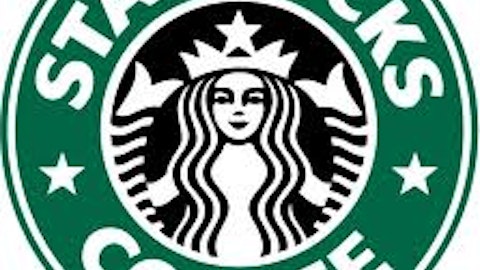We are a nation that is completely and utterly devoted to the convenience of fast food. According to data from the Pew Research Center in April, there are some 160,000 fast-food restaurants strewn across the U.S., serving approximately 50 million people each and every day. We’ve come to appreciate the convenience that fast-food restaurants offer with regard to speed of service, that some will serve us at all hours of the day, and that our food costs us far less than it would were we to eat out at an established casual-dining restaurant.

Source: Wikimedia Commons.
But the American public isn’t duped, either. A vast majority understands the cardinal rule that you get what you pay for. Although fast-food habits within the industry are evolving to meet a society that craves more nutritious foods, the history of the fast-food industry lies with greasy foods often high in fat and sodium content that have been attributed to increased chances for cardiovascular disease and other complications. In short, a good many of us know that fast food isn’t good for us, yet we tend to indulge in our vice every now and then anyway.
A disturbing trend
However, a new poll from Gallup released this week that looked at how often Americans eat at fast-food establishments and view the food they consume shed light on some truly disturbing trends.
The poll, which has only been conducted three times — in 2003, in 2006, and again in July 2013 — first asked respondents to identify how often they eat fast food. Here were the responses, according to Gallup:
| How Often Do You Eat Fast Food? | Every Day | Several Times a Week | About Once a Week | Once or Twice a Month | A Few Times a Year | Never |
|---|---|---|---|---|---|---|
| July 2013 | 3% | 16% | 28% | 33% | 15% | 4% |
| December 2006 | 3% | 20% | 33% | 25% | 15% | 4% |
| July 2003 | 4% | 17% | 31% | 30% | 13% | 5% |
Source: Gallup.
As you can see by this data, the trend shows that the American consumer is, in general, eating fast food a little less often than when this poll was conducted seven years ago. A lot of that can be attributed to increased health-consciousness campaigns, which have included placing calories visibly on menus in some states, as well as increasing public awareness about the dangers of obesity which have been linked to eating high-fat content fast food.
What was really surprising about this data — and where I was completely thrown for a loop — was the follow-up question, which asked American consumers whether they believed fast food was good for them. Here’s how they responded:
| How Would You Rate the Quality of the Fast Food You Eat? | Very Good | Fairly Good | Not Too Good | Not Good at All |
|---|---|---|---|---|
| July 2013 | 2% | 20% | 48% | 28% |
| July 2003 | 1% | 22% | 53% | 23% |
Source: Gallup. Numbers don’t add up to 100% because of rounding.
I probably shouldn’t be too surprised to discover that 76% of consumers believe fast food has little to no health value, yet fast-food revenue since 2003 has ballooned from $151 billion to a projection of $199.5 billion in 2013, according to research firm IBISWorld. In other words, consumers understand that fast food is generally not good for them, yet consumption of fast food is growing unabated. Some of this can be explained by the inflationary costs of rising prices over the past decade, but when push comes to shove, this looks like mind-numbing proof that we know it’s bad for us, yet we do it anyway!
Who eats this stuff?
I certainly shouldn’t be one to criticize, since I venture into my conveniently close fast-food restaurant about three times a month, but it just sort of leaves you wondering that if consumers understand that fast food isn’t high in nutrition, and that it can do more health harm than good, who exactly is eating this stuff? Gallup was curious about that, too, and posed this question to its respondents, breaking them down into the following subgroups:
| Frequency of Eating Fast Food | At Least Weekly | Once or Twice a Month | A Few Times a Year or Never |
|---|---|---|---|
| 18 to 29 years old | 57% | 33% | 8% |
| Men | 53% | 31% | 15% |
| Hispanics | 53% | 27% | 16% |
| Blacks | 52% | 37% | 11% |
| Annual income $75,000 or more | 51% | 28% | 21% |
| Annual income $30,000-$49,999 | 51% | 32% | 15% |
| Annual income $50,000-$74,999 | 50% | 32% | 18% |
| 30 to 49 years old | 47% | 33% | 21% |
| Non-Hispanic whites | 46% | 33% | 21% |
| 50 to 64 years old | 44% | 33% | 23% |
| Women | 42% | 34% | 23% |
| Annual income $20,000-$29,999 | 42% | 42% | 16% |
| 65 years and older | 41% | 32% | 26% |
| Annual income less than $20,000 | 39% | 36% | 23% |
Source: Gallup.
The data ultimately produce a lot of eye-opening surprises and also presented some interesting conclusions as they pertain to investing.
 Source: Zaneology, Flickr.
Source: Zaneology, Flickr.
Four key investing takeaways
No. 1: The first clear standout here is that younger people are more prone to eat fast food on a regular basis than older adults. This means fast-food restaurants need to be nimble with their ability to adjust to the changing palates and social tastes of the younger generation. If 18- to 29-year-olds are the most likely consumer to visit a fast-food restaurant on a weekly basis, that means targeting these users on social-media websites such as Facebook and Twitter to improve branding.
McDonald’s Corporation (NYSE:MCD), for example, has done its best to embrace mobile advertising during its recently kicked off Monopoly campaign, which gives away prizes ranging from food to cash to customers. McDonald’s Corporation (NYSE:MCD) has found increasing success through iAds on Apple devices early on in its campaign, whose end goal is ultimately to raise brand awareness for the company. This is also another reason McDonald’s Corporation (NYSE:MCD) was among the first fast-food chains to remodel its stores to give them a fresher and younger appearance with televisions and Wi-Fi access in many locations.

Chipotle menu. Source: eyeliam, Flickr.
No. 2: Ethnic backgrounds can also give investors clues as to which fast-food restaurants are most likely to succeed. Clearly, we as a society would love to eat fast food that’s healthier for us, but few of us, based on the data in the preceding table, are really willing to make the conscious effort to do so. To that end, creating foods that cater to certain cultures is bound to drive business.
My example here would be Chipotle Mexican Grill, Inc. (NYSE:CMG), which looks as if it could be a strong performer with 53% of Hispanics stating that they eat fast food weekly. Built upon a fresh-Mex theme, Chipotle Mexican Grill, Inc. (NYSE:CMG) offers Hispanics a menu of items that would be very appealing and comforting to their palates while also taking the pledge to use local and organic products, as well as meats that are free of antibiotics and hormones. Thus Chipotle Mexican Grill, Inc. (NYSE:CMG) offers the prospects of growing sales by targeting a demographic that tends to frequent fast-food establishments more often, but it also does this through a socially acceptable manner of utilizing healthier food options than its competitors.
No. 3: In spite of the popular belief, lower-income individuals actually visit fast food establishments less often than upper-income earners. The implication here is that, to some extent, fast-food restaurants should be focusing less on the value-menu aspects of their business and more on the higher-margin, higher-price-point items that upper-income individuals can afford.
One standout here would be KFC, which is owned by Yum! Brands, Inc. (NYSE:YUM) (which owns Taco Bell and Pizza Hut as well). KFC has traditionally stood at a higher price point than many of its peers, including McDonald’s Corporation (NYSE:MCD), and relies less on its value items and more on its pricier meal combos to drive sales. Forgiving the unfortunate chicken quality issues and subsequent flu scares KFC has suffered through in China, it has had no issues with regard to passing along higher prices to consumers in China, domestically, or in other overseas countries. With strong pricing power often come big profits.
No. 4: If we continue to eat foods known to be unhealthy for us, we’re going to support drug sectors that focus on abating the symptoms most often associated with high fast-food consumption — namely obesity, high blood pressure, high cholesterol, and potentially diabetes.
With approximately 35% of the U.S. population considered obese by the Centers for Disease Control and Prevention, this could be a golden opportunity for chronic-weight-management drugmakers to shine. Two recently approved drugs, Belviq by Arena Pharmaceuticals, Inc. (NASDAQ:ARNA), and Qsymia by VIVUS, Inc. (NASDAQ:VVUS) could be called upon in increasing numbers to treat this nation’s ongoing addiction with fast food. The target audience for both drugs is incredibly large, so the market is certainly big enough to accommodate both companies. In trials, Belviq offered the better safety profile of the two anti-obesity drugs, while Qsymia delivered the better weight-loss percentage.
The article This Disturbing New Fast-Food Data Points to a Scary Trend originally appeared on Fool.com and is written by Sean Williams.
Fool contributor Sean Williams has no material interest in any companies mentioned in this article. You can follow him on CAPS under the screen name TMFUltraLong, track every pick he makes under the screen name TrackUltraLong, and check him out on Twitter, where he goes by the handle @TMFUltraLong.The Motley Fool owns shares of, and recommends, Apple, Chipotle Mexican Grill, Facebook, and McDonald’s.
Copyright © 1995 – 2013 The Motley Fool, LLC. All rights reserved. The Motley Fool has a disclosure policy.




